How do I prove that a triangle with sides a, b, c, has an angle bisector (bisecting angle A) is of length:
$$\frac{2 \sqrt{bcs(s-a)}}{b+c}$$
I have tried using the sine and cosine rule but have largely failed. A few times I have found a way but they are way too messy to work with.

Best Answer
A method where no trigonometry is used.
Consider triangle $ABC$. Let $AD$, the angle bisector, intersect the circumcircle at $L$. Join $LC$. Consider triangle $ABD$ and triangle $ALC$.
Triangle $ABD$ is similar to triangle $ALC$ (by A.A similarity theorem). Therefore, $$\frac{AD}{AC} = \frac{AB}{AL}$$
i.e, $$AD\cdot AL = AC\cdot AB$$ $$= AD(AD+DL) = AC\cdot AB$$ $$=AD\cdot AD + AD\cdot DL = AC \cdot AB \text{ ... (1)}$$
By power of point of point result: $$AD\cdot DL = BD\cdot DC$$ $$BD = BC\cdot \frac{AB}{AB+AC}$$ $$DC = BC\cdot\frac{AC}{AB+AC}$$
In $(1)$ , $$AD\cdot AD = AC\cdot AB-BC^2\cdot AB\cdot \frac{AC}{(AB+AC)^2}$$ $$AD^2 = AC\cdot AB\Bigl(1-\frac{BC^2}{(AB+AC)^2}\Bigr)$$ If $AB = c , BC = a , AC = b$: $$AD^2 = bc\Bigl( 1-\frac{a^2}{(b+c)^2}\Bigr)$$ Hence proved.